A pond in the country with a sufficient area of the site can perform a variety of functions. A mini-pond often serves as a decorative part of the landscape, a larger pond - a pool and part of a recreation area. At the summer cottage, you can even breed fish and crayfish.
How to choose a place for a reservoir
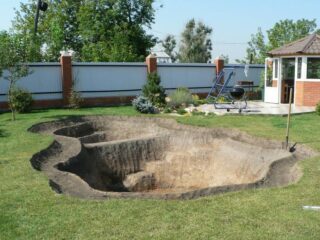
Before looking for a place for a reservoir, you should make sure that there is a fundamental possibility of making it. The Land Code allows fish farming on your site, even if the area belongs to agricultural land. However, the latter should be located and operated so as not to infringe on the rights of neighbors on the site.
Local authorities should be notified about digging a pond. Communications can pass through the site, this should be taken into account when choosing a place.
There are other recommendations related to the peculiarities of fish farming.
- The pond is dug at the local elevation. If it is in a lowland, dirty rain and flood water will flow here. If there is no elevation on the site, you will have to build it yourself.
- No tall trees and bushes are planted near the fishing pond. Fallen spills rot in the water, and the size of the artificial pond makes it impossible to hope for natural cleaning. If the vegetation cannot be removed, the pond will have to be manually cleaned frequently.
- The reservoir must be under the sun for at least 7 hours a day. In the absence of light, the flora reproduces too slowly and the fish will starve. Permanent lighting is also not allowed. To create a shadow, artificial fences are mounted.
- Choose a site with clay soil - it holds water better.
- The area of the reservoir is determined by the number of farmed fish. Overpopulation leads to high consumption of food and water bloom.
The pond on the site should not communicate with natural bodies of water. The latter are federal property. If the pool on the site is connected to them, it also becomes the property of the state.
What shape to make a pond on the site
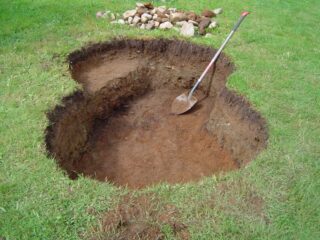
The shape of the reservoir on the site is of no practical importance. The only important condition is the multilevel bottom. Thanks to such a relief in small areas, the water will warm up more strongly, and the microflora will multiply more actively. In deeper areas, the fish will hibernate.
The configuration of the shores is determined only by aesthetic considerations. Most often, they try to give the pond a resemblance to the natural one. Usually it has an oval shape, one gentle bank. An elongated shape is allowed - it is more convenient for organizing the relief. Rectangular or round is found in a garden with an appropriate landscape.
How to determine the size of the reservoir
To dig your pond, you need to correctly assess the tasks, the area of the site, the budget. It is not recommended to make the pool more than 30% of the total area of the territory. The tips are as follows:
- Swimming and fishing ponds are incompatible, even if the latter is large.
- The depth is at least 1 m and no more than 3 m.
- When calculating the depth, take into account how much the water freezes in the region. In the northern regions, a pond 1 m deep will freeze completely.
- The size of the reservoir depends on the number of fish. The calculation is made from the following ratio: 50 liters for one fish measuring 10 cm.Carp or whitefish will require more water.
- Dimensions of 15-50 m² are considered optimal.
When calculating, it is important to remember that the water in an artificial pool is not naturally renewed. That is, maintenance of the pond requires a water supply system, a pump, a storage tank and other equipment.
The Subsoil Law states that a citizen has the right to use land only to a certain depth - 5 m. Therefore, the maximum possible depth of the basin does not exceed 5 m.
How to dig a pit
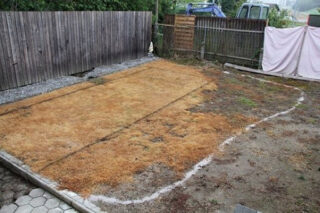
Before digging a pit, its contours are marked on the site. If it has a rectangular shape, pegs are installed in the corners, tied with a cord. If the configuration is complex, you will have to lay the rope along the entire proposed contour and secure its position with pegs or stones. You can also use a spray can of paint and just draw outlines on the ground.
First, the pit is deepened to the depth of the coastal zone. Then they outline the area where the bottom should be deeper and dig a hole in this area. If there is a third deepest zone, the operation is repeated, resulting in a multilevel bottom.
Fertile soil is first removed from the site and used on the site. The rest of the land is not recommended to be exported, but used as a material for changing the relief.
Digging methods
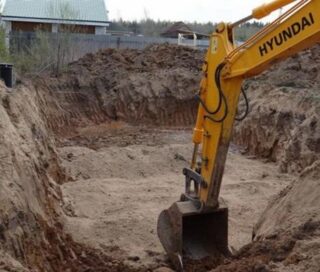
You can dig a pit by hand or using technology.
- Excavator is a faster way. The excavator develops a lot of power. If the bottom of the reservoir is even, the pit can be dug in 1 day. In practice, this takes more time, since it is required to mark the depth levels according to the plan, and this can be done only after a hole has been dug at a certain level. The main disadvantage of this solution is the price. But there is also a limitation on the minimum volume of excavated soil. The technique is usually used to dig a large pool.
- Manually with a shovel. Workers are hired to dig trenches. It takes a lot longer, so in the end it is not much cheaper than using the technique or even at the same price. However, you can manually dig a pond of any configuration and with a complex relief bottom.
An obligatory element of work is tamping. Regardless of the type of base, the topsoil should be compacted. For this, it is better to use a vibrating plate.
How to choose waterproofing
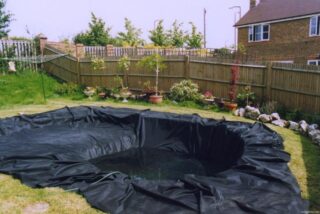
It is important not only to dig a pond, but also to choose the right base. The soil allows water to pass through. To keep the liquid for a long time, it is necessary to waterproof the bottom and walls. Different methods are used for this.
- A clay castle is the simplest option, quite affordable for doing it yourself. Clay is used greasy, almost without sand. Previously, soot is poured onto the bottom of the trench - it scares away worms. Then the clay is laid out in 3 layers so that the total thickness of the castle is 15 cm. Each subsequent layer is applied after the first one has completely dried. The technology is labor intensive and time consuming. But the cost is minimal.
- Another simple solution is HDPE film. The material is durable, wear-resistant, completely waterproof. For the pool, take a film with a thickness of at least 3 mm. It is advisable to lay 1 large piece, which would be enough to cover the entire bottom. If this is not possible, the largest possible fragments are acquired. The sheets are connected together by soldering or glue. Overlap. The edges of the film must extend beyond the edges of the pool. You need to spread the film on a tamped sand pillow.
- Concreting - requires more material costs, but it is also the most reliable solution. Concrete itself also allows water to pass through, therefore, a waterproofing film is first laid on the bottom and walls of the pit. But concrete gives the pool mechanical strength and durability. The concrete layer must be reinforced with reinforcement.Concrete waterproofing, unlike film, does not need to be updated over time.
- Plastic - this option is suitable only for small ponds where fish are bred for decorative purposes. The pool is a ready-made plastic form buried in the ground. The easiest way to make such a pond is to dig a trench, compact the bottom, place a mold in the recess and bring the pipes. Plastic models are durable: they last 20-30 years.
Slope requirements
Requirements for the walls of the reservoir are the same as for the bottom. The main factor is collapse prevention. However, it is more difficult to compact this part of the reservoir. In addition, you cannot knead a crushed stone pillow here. The ramming is performed simultaneously with the compaction of the bottom with a vibrating plate.
Slope angle - not less than 60 degrees.
Since not only "planned" water will enter the pool - from the aqueduct, but also rain and flood water, there is a danger of overflow of the reservoir. To avoid uncontrolled drainage of water, the place where the excess liquid will flow out is determined in advance. Here they install a pipe, stick it to the film and put a grate on it so that when draining the fish does not fall into the pipe.
Drain water into gravel or drainage area.
Common mistakes of amateur designers
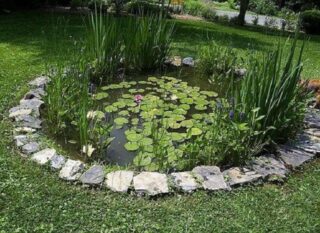
An artificial pond for breeding carp or crayfish is a rather complicated structure to install and operate. Mistakes when choosing a place, starting fish, even pond decor result in loss of livestock and water bloom.
- The main mistake is the installation of too powerful filters. In an attempt to purify water as much as possible, amateurs often install carbon and polymer filters. However, the latter destroy all biological forms, while in the pond the latter constitutes the lower part of the food pyramid. It is better to do with biological treatment, and remove the excess algae manually.
- The bottom of the pool is often laid out with stones. Only flat rounded gravel can be used, not recycled crushed stone, for example, or broken brick. The corners of the latter cut the film easily.
- When decorating the banks, it is also allowed to use only rounded stones. Lay them out in rows so that the lower ones serve as a support for the upper ones.
- Plants in the pond are not chosen for their beauty, but for compatibility with the fish living here.
- Low plants are planted around the reservoir, which do not give abundant flowering.
It is necessary to control the acidity level of the water. When the indicator drops to 5, it is necessary to dissolve a portion of limestone or soda in the pool.








